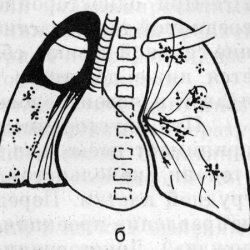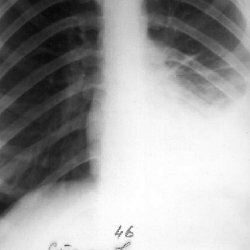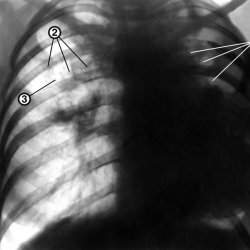Lung diseases in humans: a list and their symptoms, treatment, prevention
Content
- Pulmonary system overview
- Diseases of the lungs
- Asthma
- Chronic obstructive pulmonary disease
- Pulmonary fibrosis
- Lung disease infections
- Lungs' cancer
- Pulmonary hypertension
- Lung embolism
- Bronchopulmonary dysplasia
- Respiratory distress syndrome
- Acute Respiratory Distress Syndrome
- Cystic fibrosis
- Alpha-1-antitrypsin deficiency
- Other lung diseases
- Signs and symptoms of lung disease
- What examinations do you need to undergo?
- Laboratory tests
- Lung function tests (pulmonary function tests, PFT)
- Visual examinations
- Other diagnostic methods
- Treatment and prevention of lung diseases
Pulmonary system overview
The lungs are part of the respiratory system and are located inside the chest, above the diaphragm. Lungs - These are complex organs that are composed of spongy, elastic tissue designed to absorb oxygen and get rid of carbon dioxide.
Oxygen enters the lungs when we breathe in. It is distributed to the lungs by a system called the bronchial tree, which has smaller branches (called bronchi and bronchioles). Bronchial tree
carries oxygen to small sacs (alveoli) deep in the lungs, where oxygen (taken from the inhaled air) moves from lung into the bloodstream, and carbon dioxide (a byproduct of our metabolism) travels from the bloodstream to the lungs and is released when you exhale.Oxygen intake and the delivery of this oxygen (through the blood) to the tissues is necessary for the functioning of all cells in our body. Removal of carbon dioxide necessary to maintain blood pH at an appropriate level as part of the body's acid-base balance system.
Since the air we breathe contains many components from the environment (such as dust, pollen, bacteria, viruses, smoke and volatile chemicals), the lungs maintain a defense system against these potentially toxic invaders. Lung protection system depends on immune cells and mucus secretion to contain and remove these unwanted components from the lungs.
Diseases of the lungs
Lung disease is a condition in which lung function is impaired. In some cases, the problem lies in the process of gas exchange that occurs in the membrane between the alveoli and the blood; this prevents efficient oxygen uptake and carbon dioxide removal.
In other cases, the problem is the inability of the bronchial system to efficiently deliver air to the alveoli, possibly due to blockage of the branches. bronchial tree or due to the fact that the muscles of the chest do not expand and contract enough to move air through the bronchi (tree in alveoli).
Sometimes the problem is the lungs' inability to remove or detoxify foreign matter, possibly due to a major deficiency or due to the huge amount of these substances that overload the defense systems lungs.
A list of common lung diseases in humans include:
Asthma

Asthma is a chronic lung disease characterized by inflammation of the bronchi and bronchioles and episodes (attacks) of airway obstruction.
People with asthma are sensitive to various substances that do not cause the same reaction in other people.
Asthma attacks can be caused by cigarette smoke and other air particles, dust, mold, allergens, exercise, cold air, and many other factors. The triggers for each person can be different. During an attack, the bronchial tree of the airways swells, and the muscles surrounding the bronchi contract, narrowing the airways.
The secretion of mucus can further obstruct the flow of air, making it difficult to inhale and causing labored breathing in humans. Most episodes do not cause permanent damage to the lungs, but often require immediate medical attention because a lack of oxygen and a build-up of carbon dioxide can be dangerous for life.
Asthma is the most common chronic illness in childhood. Affects more than 10 million Russians, where 1 in 6 children and 1 in 9 adults.
Chronic obstructive pulmonary disease

Chronic obstructive pulmonary disease (COPD) is a term used for both emphysema of the lungsand for chronic bronchitis.
Read also:Altitude sickness
In chronic bronchitis, the bronchi become inflamed and scarred. With emphysema air sacs in the lungs decay slowly. In both disorders, it becomes increasingly difficult for patients to breathe out and get enough oxygen when inhaling.
Smoking causes 80 to 90 percent of COPD-related deaths. Other risk factors include exposure to air pollution.
Pulmonary fibrosis

Pulmonary fibrosis is an interstitial (between adjacent tissues) lung disease. Pulmonary fibrosis causes damage and scarring of tissues between the air sacs, inflammation of the air sacs, and scarring of the lungs. Causes pulmonary fibrosis include:
- occupational or environmental exposure to small particles (including repeated exposure to inorganic substances such as asbestos, coal, beryllium and silica);
- repeated exposure to organic matter (mold, hay, animal droppings and grain dust), which can cause hypersensitivity pneumonitis and ultimately lead to pulmonary fibrosis;
- chemicals and drugs that are toxic to the lungs;
- radiation therapy;
- sarcoidosis of the lungs;
- scleroderma and others autoimmune diseases;
- fibrosis can also be idiopathic (i.e. e. arising independently or for an unknown reason).
Lung disease infections

Infections can occur mainly in the lungs, develop in the pleura (the membranes that surround the lungs), or affect the entire body (including the lungs). They can be acute or chronic and can be caused by bacteria, viruses and, less commonly, fungi.
Pneumonia Is an acute inflammation of the lung tissue caused by various microorganisms. Flu Is an acute systemic illness caused by a virus and includes respiratory symptoms (fever, headache, cough, lethargy).
Tuberculosis and non-tuberculous mycobacteria (NTMs) are chronic infections most commonly seen in patients with compromised immune systems, (e.g., HIV /AIDSohm).
Mycobacterial infections develop slowly and can be systemic or localized to the lungs.
Lungs' cancer

Lung cancer is the uncontrolled growth of malignant cells in the lungs. There are two main types: small cell and non-small cell lung cancer.
Other cancers that can spread to the lungs are considered metastatic because cancer cells do not originate in the lung tissue itself, but spreads from the liver or bone, for example.
In recent years, the number of deaths from lung cancer has increased in women, while in men it has decreased.
Lung cancer is currently the leading cause of cancer death in general. Lung cancer risks include:
- active smoking;
- passive smoking;
- occupational exposure to the processing of asbestos, steel, nickel, chromium and coal gas;
- irradiation.
Pulmonary hypertension
Pulmonary hypertension (LH) is a lung disease characterized by narrowing of the blood vessels in the lungs, which raises their blood pressure and forces the heart to work harder to deliver blood to the lungs. This condition can provoke (and worsen) various lung diseases, which can lead to heart failure.
Lung embolism
Pulmonary embolism is a blood clot that usually occurs in the veins of the legs or pelvis and travels to the lungs, where it blocks a blood vessel, causing chest pain, severe shortness of breath, and coughing. This condition can be life-threatening and requires immediate medical attention.
Bronchopulmonary dysplasia

Bronchopulmonary dysplasia (BPD) is a lung disease that occurs primarily in premature infants who have received long-term oxygen therapy and / or have been on mechanical ventilation for a long time, but can also be observed in those who have experienced oxygen toxicity or have suffered pneumonia. ,
In this condition, the airways become inflamed, do not develop normally, and can be damaged.
Respiratory distress syndrome
Respiratory distress syndrome (RDS) is a childhood disease. RDS in a newborn is a life-threatening breathing problem that can develop in babies born more than 6 weeks before due date (i.e. e. premature).
Read also:Acute Respiratory Distress Syndrome (ARDS)
The lungs of these premature babies are not sufficiently developed to produce enough of a protective liquid substance in the lungs called surfactant. Without surfactant, the lungs cannot expand or inflate properly, and children have difficulty breathing enough oxygen.
The condition can occur within hours of a premature birth.
Acute Respiratory Distress Syndrome
Acute Respiratory Distress Syndrome (ARDS) is the rapid onset of severe breathing difficulties due to extensive inflammation and fluid filling of the lungs. This condition can be fatal.
ARDS can be caused by many types of direct or indirect lung injury, including a serious viral or bacterial infection, sepsis, trauma, multiple transfusions, drug overdose, or inhalation of substances (such as salt water or smoke).
Cystic fibrosis
Cystic fibrosis (cystic fibrosis) is an inherited disorder that affects the lungs, pancreas, and other systems of the body.
Cystic fibrosis is characterized by salty sweat, a thick mucus in the lungs that can make it difficult to respiration, and a reduced ability to digest fats and proteins, which leads to impaired absorption in the intestines.
It is more common in Caucasians than in other ethnic groups and is usually diagnosed in infancy.
Alpha-1-antitrypsin deficiency

Alpha-1-antitrypsin deficiency Is a hereditary protein deficiency that protects the lungs.
Without this protection, the lungs become more and more damaged, and the patient has a significantly increased risk of developing early emphysema and liver diseases.
Other lung diseases
Other disorders do not directly affect the lungs, but they impair a person's ability to breathe properly because they affect the chest cavity, muscles, nerves and / or heart.
These disorders include various conditions such as neuromuscular diseases (muscular dystrophy, polio, myasthenia gravis, Guillain-Barré syndrome and amyotrophic lateral sclerosis) and disorders that lead to abnormal development of the spine or movement of the chest, which can limit the expansion of the lungs.
Note: specific evaluation and treatment of these disorders is not covered in this article.
Signs and symptoms of lung disease
Signs and symptoms associated with lung disease vary from person to person and change over time. In chronic conditions, symptoms often appear gradually and progressively worsen.
In acute conditions, symptoms can range from mild to severe. Certain illnesses can be life threatening without immediate medical attention.
While each disease is different, there are common signs and symptoms that are seen in many lung conditions, including: persistent cough and shortness of breath.
People may wheeze, choke, and cough up blood or phlegm, and experience chest pain. People with obstructive pulmonary disease (such as COPD) may have exhalation problems (some describe the condition as "trying to breathe through a straw").
Lack of oxygen can lead to the patient's skin will acquire a bluish tint. Over time, lack of oxygen in some people can lead to the emergence of clubs (enlarged fingertips and abnormal nail growth).
What examinations do you need to undergo?
Tests are conducted to diagnose lung diseases, determine their causes (where possible) and assess their severity.
Many doctors prescribe arterial blood gas test to assess the level of oxygen and carbon dioxide, pulmonary function tests (PFT)to help diagnose and monitor lung function, and chest x-ray and / or CT (computed tomography)to look at the structure of the lungs.
Other tests are also done to help diagnose certain diseases.
Laboratory tests
- Blood gas analysis - an arterial blood sample is collected to assess blood pH, oxygen, and carbon dioxide;
- Complete blood count (CBC) - looking for anemia;
- Cystic fibrosis tests (CFTR gene analysis, sweat chloride, immunoreactive trypsin (IRT), fecal trypsin, pancreatic elastase) - to look for genetic mutations that cause cystic fibrosis, and for diagnosis the disease itself;
- Alpha-1 antitrypsin - to determine if the patient has an AAT deficiency;
- Saliva analysis - to diagnose lung infections caused by bacteria;
- AFB smear and culture - for the diagnosis of tuberculosis and non-tuberculous mycobacteria (NTMB);
- Blood cultures - to diagnose bacteria and sometimes yeast infections that have spread into the blood
- Analysis influenza virus - for the diagnosis of influenza;
- Lung biopsy - to evaluate lung tissue for damage and cancer
- Sputum cytology - to assess lung cells for pathological changes and cancer;
- Tests for the content of drugs in the body - to identify overdoses that lead to decreased breathing or acute respiratory failure.
Read also:Blood in sputum (hemoptysis)
Lung function tests (pulmonary function tests, PFT)
Some of the more common tests are listed below.
- Spirometry - measures the amount and rate of expiration of air as the patient is blown out through the tube. It is done to evaluate a narrowed or blocked airway.
- Air flow with a peak flow meter - measures the expiratory flow rate. Asthma patients can do it at home to control their condition.
- Lung volume - measures the amount of air that a person takes into the lungs, and its remainder in the lungs after exhalation. It helps assess lung elasticity, chest movement, and muscle strength associated with breathing.
- Measurement of the diffusion capacity of the lungs - the transfer of oxygen from bags with pulmonary air into the bloodstream is investigated by assessing the absorption of carbon monoxide by inhalation of a small amount (not enough to cause harm).
Visual examinations
- Chest X-ray - examination of the structures of the lungs and the cavity of the chest;
- CT (computed tomography) - allows a more detailed assessment of the structure of the lungs;
- MRI (Magnetic Resonance Imaging) - provides detailed images of the organs and vessels in the chest;
- Ultrasound examination (ultrasound) - detects fluid between the pleural membranes;
- Nuclear lung scan - helps detect pulmonary embolism and is rarely used to evaluate the effectiveness of lung cancer treatment;
- Positron Emission Tomography (PET) - helps diagnose lung cancer.
Other diagnostic methods
- Electrocardiogram (ECG) - analyzes your heart rhythm to determine if heart disease is affecting breathing
- Sleep tests - help determine if a person is breathing normally while sleeping and are usually done in special sleep and wake centers.
Treatment and prevention of lung diseases
Lung disease treatment aims to prevent disease wherever possible; treat infections and prevent them from spreading to other people; reduce inflammation; stop or slow the progression of lung damage; relieve symptoms; make breathing easier; minimize side effects associated with certain treatments; provide victims with sufficient oxygen.
Many cases of lung disease can be prevented by quitting smoking by minimizing exposure to particulate matter (such as asbestos, coal, beryllium, silica, mold, grain dust, air pollution) and chemicals and drugs known to affect lungs.
People with a weakened immune system or pre-existing lung disease, or very young or elderly people should talk to their doctor about the appropriateness annual flu injections and pneumococcal vaccinesto minimize the risk of getting the flu and pneumonia.
New treatments for lung disease continue to be developed and patient needs for treatment change over time. Patients should talk to their doctors periodically about the treatments that are appropriate for them.



